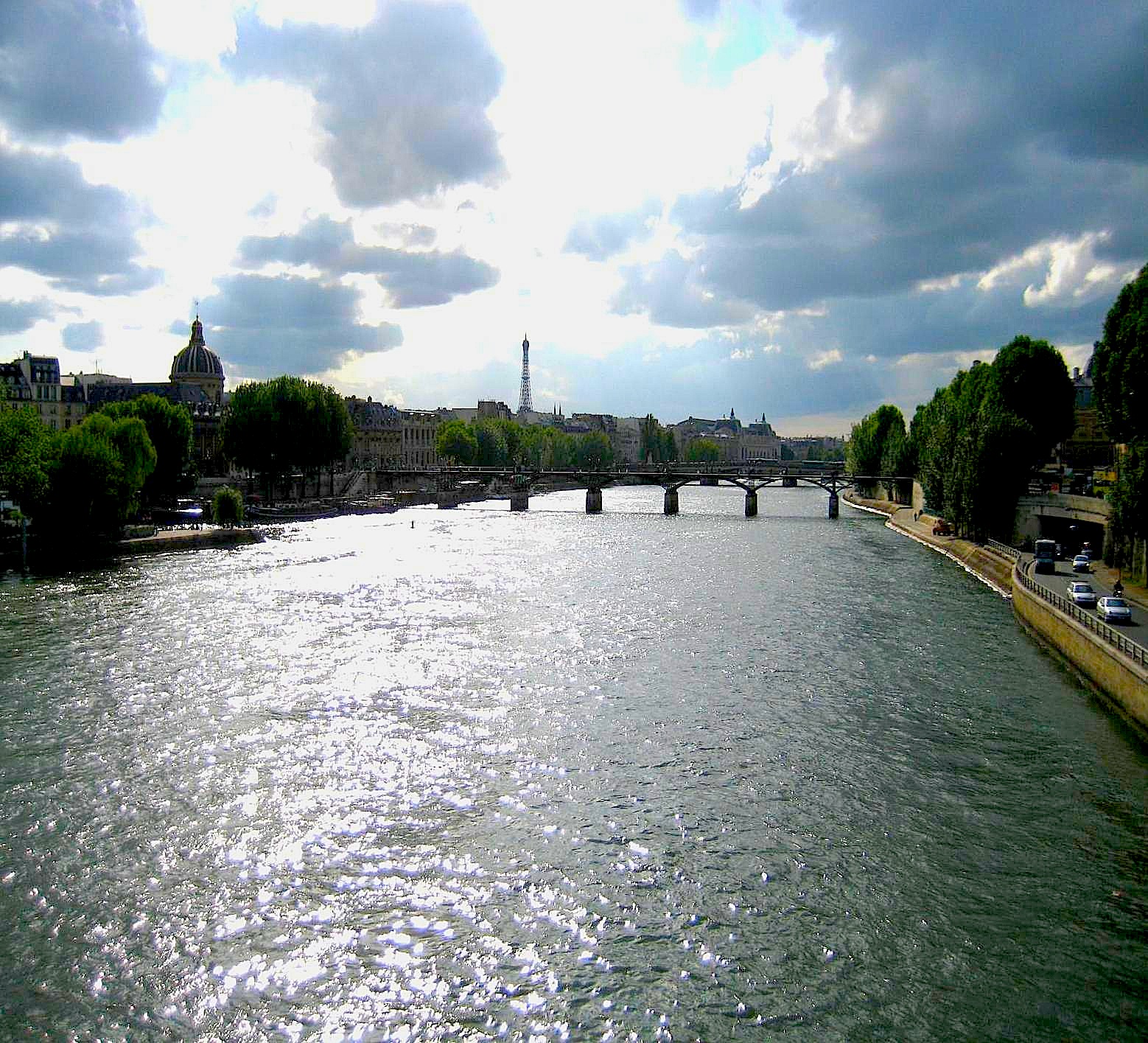| Oct/Nov 2010 • Travel |
| Oct/Nov 2010 • Travel |
Five years ago, in 2005, I lived with my family in the thirteenth arrondissement in Paris, in a set of late medieval buildings tucked away behind the Manufacture des Gobelins and alongside the Square René Le Gall. This past spring I returned to spend a month by myself on the other side of Paris, in the tenth. I was a block from the Gare de l'Est and two blocks from the Gare du Nord, which might make anyone who has come in late at night on the Eurostar from London and flung suitcases into the back of a taxicab think that my surroundings were dingy and sinister. On the contrary! Around the corner from my apartment, at the intersection of the Boulevard Magenta and the rue du Faubourg St. Martin, was the Eglise St. Laurent: in front of the portal the pavement was broad and usually populated by families of gypsies sitting on the benches, talking, waiting for the wind to lift or evening to descend, and amusing their younger children. To the side was a set of cream-colored seventeenth century outbuildings with burnt umber roofs and a small and verdant though somewhat disheveled park, and just behind was a set of cafés and plane trees on the tiny rue St. Laurent that seemed still to belong to a vanished village square. The church itself was founded along with a monastery in the sixth century, outside the city walls, but that little enclave was destroyed by Normans in the ninth century. The present church was started in the early fifteen century in flamboyant Gothic and constructed in fits and starts (it was called the Temple of Hymen and Fidelity for a few years after the French Revolution!) through the nineteenth, when in 1867 Constant-Dufeux completed the building with an unfortunate neo-gothic façade that replaced the probably much handsomer Italianate classical façade of 1621.
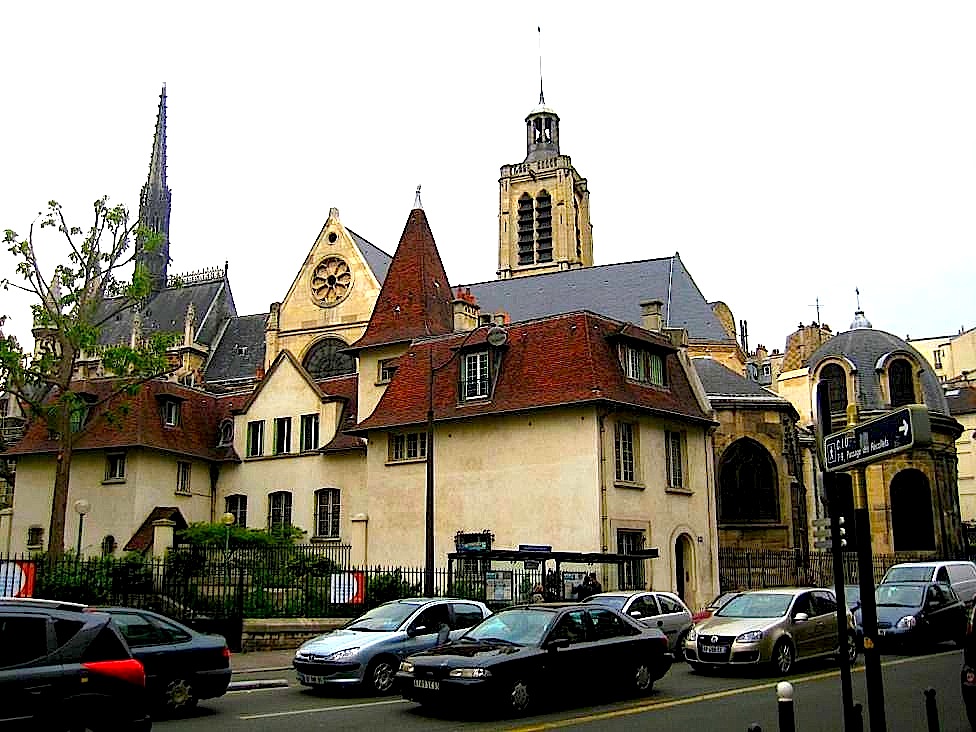
My apartment was just a few doors down, 64 boulevard Magenta. Perched at the tip of an acute triangle on the top (sixth), it was very much like a ship's cabin tucked into the prow of some great vessel: in two diminutive rooms I was the brief proprietress of a bathroom with stall shower, a table and chairs, a sofa-bed, a "kitchen," a postage stamp armoire, a bedroom with chandelier, bookshelves, a toilet, and a washing machine. A drying rack and ironing board were hidden under the bed. Tout le nécessaire! And on one unforeseen morning, a bearded and hatted clochard was also provided, sleeping like a great bear rug in the hallway right in front of my door. The apartment-tip was glazed with a tall, two-winged window that kept me from feeling claustrophic and looked down the rue St. Martin to the neo-gothic spire of the Mairie of the tenth arrondissement, thence to the blue roof of the Pompidou Center, and far away on the other bank of the Seine, the dome of the Pantheon. Just outside the window was a faux balcony with three flower pots that my friend Cinda Agnew Musters helped me to fill with feathery deep-blue lobelia, shortly after I dug out the earlier, ghastlier inhabitants with a spoon. (We bought them at the nearby covered market, the Marché St. Quentin.) A few days later, the famous alpine bees of Paris found them and returned every morning to buzz around, though I'd been expecting seagulls.
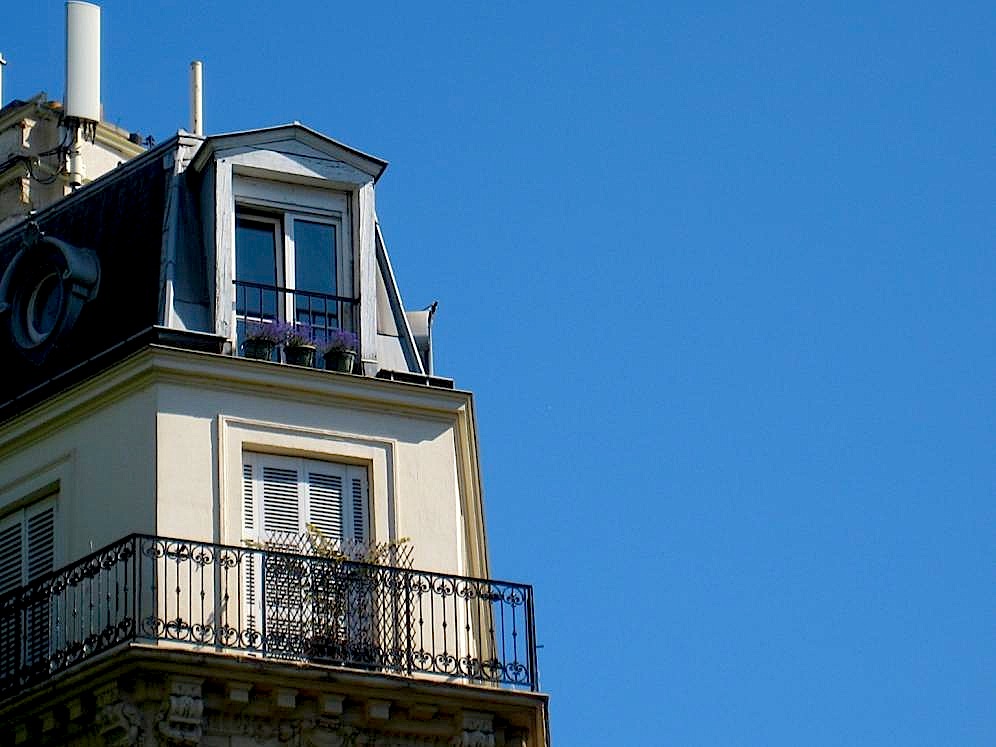
I spent a month in Paris to deliver a series of lectures at the University of Paris Nanterre, the tenth segment of the University of Paris (whose first four segments comprise the Sorbonne and whose seventh is called the University of Paris Denis Diderot and harbors my research group, once REHSEIS, now SPHERE, the name of which is now easier to remember but doesn't actually stand for anything—an acronym without the nyms). Nanterre lies beyond the great cluster of skyscrapers called La Défense just west of Paris, a prolongation of the Champs-Elysées. The invitation, though at the kind request of my friend Martine de Gaudemar, proved quixotic. Although I had to fill out the usual spate of French administrative forms and bring my birth certificate with me as well as a flowery attestation of its authenticity provided by the French embassy in Washington, D.C., so that by the end of the month the university had deposited half my salary into the usually depleted French bank account I maintain for just such occasions (I suppose the other half will eventually appear as well), the philosophy department nontheless paid no attention to my lectures. It was very strange. The same thing happened to my friend Karine Chemla (former director of REHSEIS and a scholar of classical Chinese mathematics) when she went for a month to the University of Sao Paolo in Brazil, so that was some consolation.
In the United States, philosophy departments are typically divided into warring factions that style themselves "analytic" and "continental," depending on whether they owe their allegiance to Rudolf Carnap or Martin Heidegger, but at Nanterre the warring factions bear the standards of two seventeenth century philosophers: there are the Leibnizians on the one hand and the Spinozists on the other. My colleagues were apparently distracted by a flare in hostilities over the metaphysical conundrum of the reality of the unactualized possibles, which Spinoza rejects and Leibniz makes the centerpiece of his doctrine of human freedom. I was partial to Leibniz to begin with, but after four sessions of lecturing (in French) to so many unactualized possibles, freely though dutifully, I felt confirmed in my choice of metaphysics. I began my lectures by deploring the hyper-rationalism of Carnap and the irrationalism of Heidegger, urging my colleagues to search for a middle ground, which in French is "terre d'entente." Little did I realize that I should have been urging them to find a middle ground between Leibniz and Spinoza; I suppose that would be Malebranche. In any case, I suggested Cassirer's philosophy of symbolic forms on the one hand, and the University of Chicago school of philosophical rhetoric on the other, whose exponents include Richard McKeon and his friend Kenneth Burke, Wayne Booth and his friend Jamie Redfield, Eugene Garver, Martha Nussbaum, our president Barack Obama, and Paul Kahn, David Luban, and myself (we three went from the University of Chicago to the philosophy department atYale for graduate work around 1970).
The first lecture was really about Simone de Beauvoir, so I used the School of Chicago as the conceptual frame to analyze the trajectory of Beauvoir's writings from the early Ethics of Ambiguity to The Second Sex to later works on old age and her political journalism (and activism), from the descriptive and ontological to the performative and practical. I invited a few friends to help "animate the discussion" afterwards (as the French say): Claude Imbert, former head of the philosophy department at the Ecole Normale Supérieure (rue d'Ulm), Constance Borde and Sheila Malovany-Chevalier, the two translators of the new English edition of The Second Sex, and Sarah Glazer, the journalist whose trenchant New York Times article—on the long struggle to persuade Knopf to authorize a new translation that might replace Parshley's lamentable and truncated version—played a key role in subsequent events. Glazer was another University of Chicago graduate, though she majored in history instead of philosophy. Claude was also keenly interested in locating a new middle ground for philosophy; she blamed the current impasse on Kant and also found inspiration in Cassirer and the Warburg school, as well as Mauss, Levi-Strauss, and Merleau-Ponty (and therefore the disciplines of anthropology and art history). Sheila, Constance, and I met a week later at a colloquium with Michèle Le Doeuff at Reid Hall, Columbia University's beautiful Paris campus, to discuss the new translation and revisit the impact of The Second Sex on twentieth century politics and letters.
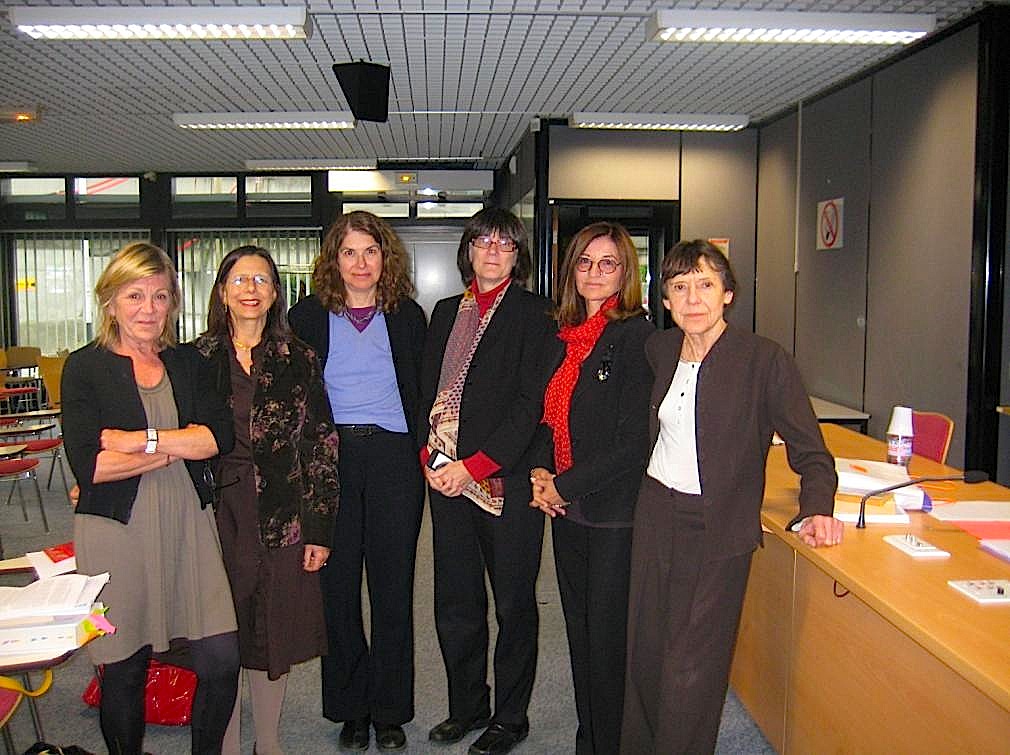
After my lecture, we all repaired to the Brasserie Flo (okay, it's a chain, but a respectable one) in the newly renovated Gare de l'Est. The French railway system SNCF has recently invested 60 million euros in this renovation, because the station has a new TGV (highspeed rail) link that heads, naturally, east to Strasburg and Germany. Since TGV trains attract a more affluent clientele, the scouring of the mid-nineteenth century façade (Napoleon III inaugurated it in 1850) and the Art Deco interior walls, and the construction of a new internal roof with inset yellow and white glass roundels, has been accompanied by the installation of high-end boutiques. These boxlike stores clustered inside the great halls seem to me like an architectural quotation of the Musée d'Orsay, with over-sized shoulder bags and linen blazers replacing Belle Epoch academic painting. And in fact there is one monumental, tragic painting that belongs to the Gare de l'Est: "Le Départ des poilus, août 1914," the depiction of young men going off to war on a train. It was painted by an American, Albert Herter, as a memorial to his son who died near Château-Thierry in 1918.
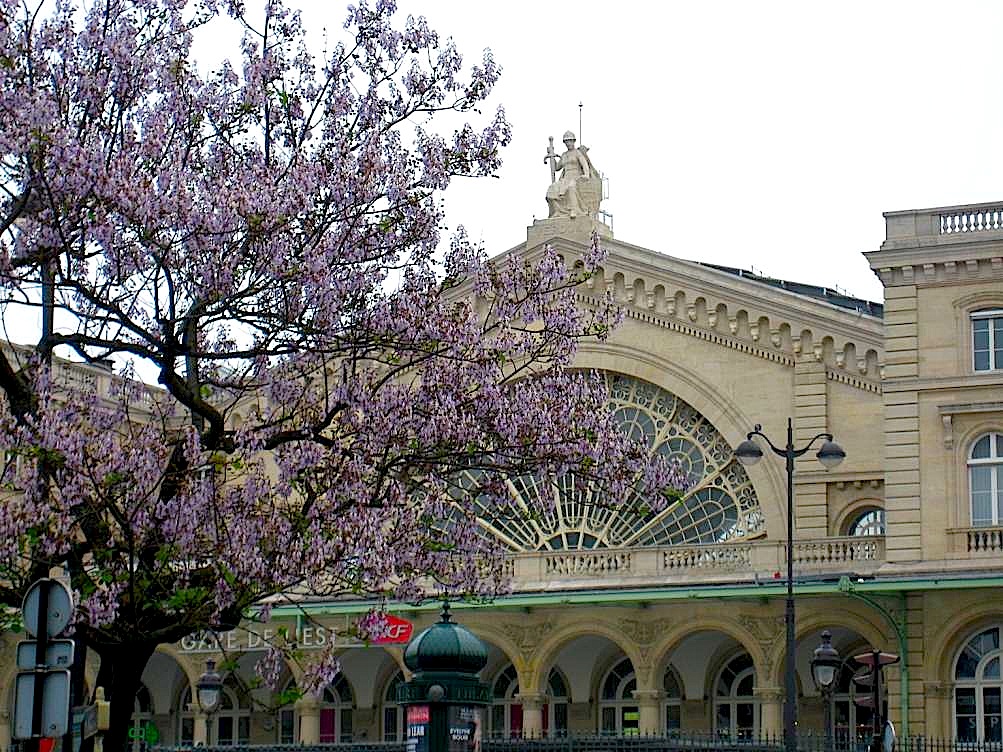
The day before, Sarah and I had inspected the boutiques and restaurant (and two beautiful Art Deco staircases), and then crossed the plaza in front of the station, which was filled with flowering paulownia trees—a cloud of pale purple blossoms—to investigate the former monastery attached to the Eglise St. Laurent: the Ancien Couvent des Récollets, a reform order of the Franciscans. It is a vast, stunningly handsome edifice built in the early seventeenth century that now houses the professional association of architects in the Ile-de-France and forms one side of the Square Villemin, a square-park that is actually a rectangle. We walked across the park, past two white mulberry trees growing sideways amid masses of rhododendrons and azaleas in riotous bloom, and came out on the Canal St. Martin. Sarah is a passionate cyclist, and was delighted to discover that my corner of the canal (it makes a sixty-degree bend just there) was the bit that she'd caught a glimpse of earlier in the spring, while cycling from the Gare d'Austerlitz to the Gare du Nord, en route from an organized trek in the Loire. She showed me the proof, a snapshot in her camera of the sherbet-color storefront façades of Lili & Antoine, raspberry, lime and lemon. But in real life, in May, they looked even showier, framed by the pink and white, yellow and green candelabras on the horse-chestnut trees that flanked the canal. Even though it was cool and windy, we walked all the way up to the Rotunda de la Villette, which stands just where the canal widens to form the Bassin de la Villette. It was built by the architect Ledoux around 1785 both to evoke the villa Rotunda of Palladio and to serve as part of an elaborate barrier to protect Paris from the importation of contraband, a problem that still vexes the French police.
We kept walking because I wanted to show Sarah the store that sold heavy, black-laquered Beijing bicycles and old-fashioned French hot chocolate with the consistency of pudding (to the tune of Amazonian birdsong) that I discovered with my son William five years earlier, but it seemed to have vanished. So we never got to the Canal de l'Ourco which flows through the Parc de la Villette, studded with a concert hall, a theatre, small designer gardens, and the Museum of Science and Industry, nor to the Canal St. Denis that turns north to skirt the parish of the great cathedral, where the kings of France still lie in state and where Abbé Suger invented the Gothic style. Instead, we settled for cappuchinos and a view of the new apartments that look down over the canal, in one of the many cafés that have sprung up like great mushrooms with fruit-and-garland plaster molding instead of gills.
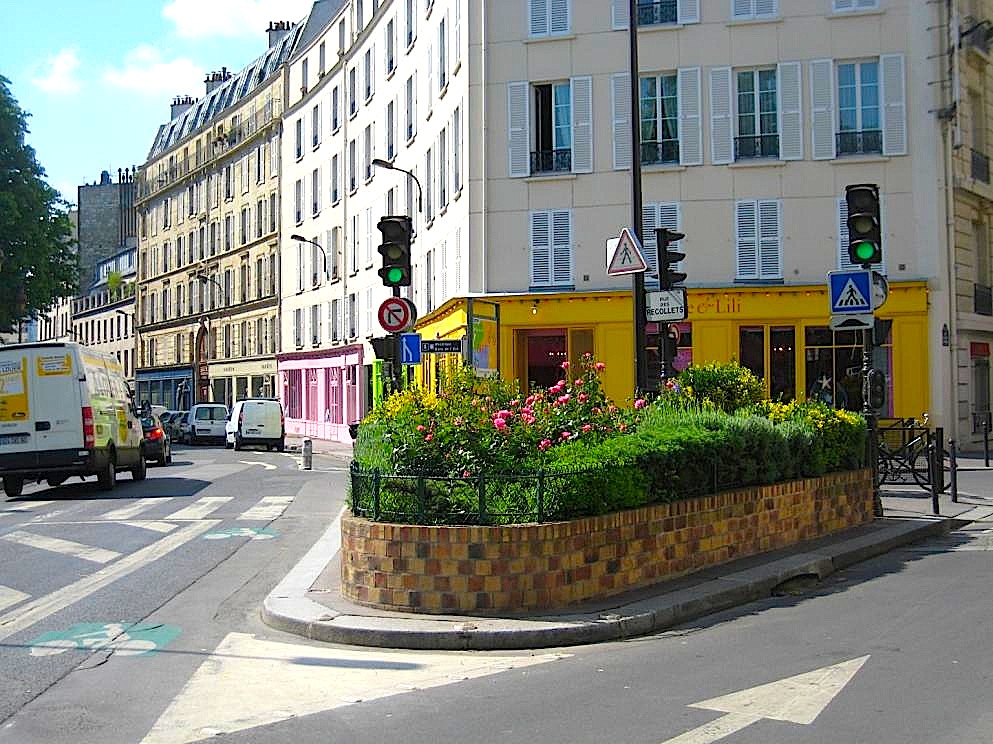
I remember walking along the Canal St. Martin thirty years ago, when it was rather seedy, like the Hôtel du Nord made famous by Marcel Carné in his 1938 film, and was still plyed by barges carrying freight. Now the barges carry only tourists, who wait patiently in the locks as the water level rises or sinks, the cross streets swivel or split in two, and who take snapshots of the dank green walls above them. Two blocks south from my corner, the canal is "suppressed" beneath the boulevard Jules Ferry (a nineteenth century politician famous for making public education free, secular, and mandatory, and so for promoting the education of young women) which then becomes the boulevard Richard-Lenoir (two industrialists who brought the cotton trade to Paris). The two lanes of this trinomial boulevard are thus divided by a green park-strip nine blocks long, which forms a roof for the subterranean canal and ends at Place de la Bastille, where the tourist barges emerge again into the sunlight, their passengers blinking and looking relieved.
I didn't spend all my time in Paris walking along the canal; I often took the Métro (Line 5) across the Seine at the Gare d'Austerlitz, where you catch a glimpse of Notre Dame as you rattle over the bridge, on the way to my research group SPHERE in their new offices near the Bibliothèque Nationale François Mitterand. The seventh segment of the University of Paris is now installed in a series of renovated industrial warehouses and mills along the river: les Grands Moulins, le Halle aux Farines, les Frigos. My research group is in the Bâtiment Condorcet, next to the cosmologists, which seems fitting. During the month of May, my group was a hive of activity. There was a party (accompanied by the launch of a special issue of Historia Mathematica) to celebrate the 70th birthday of Henk Bos; his books and articles on Descartes' Geometry and the origins of the infinitesimal calculus have formed a generation of younger scholars, historians, and philosophers alike. The celebrations were prefaced by a day-long colloquium on projective geometry and projective methods. They interested my colleague Mic Detlefsen (who had been invited to Paris and Nancy for five years, with a big grant from the French government, to study "Ideals of Proof") because they postulate points at infinity, which redeem their ideal and therefore metaphysically fraught status by their usefulness, since they allow for important dualities (two theorems for the price of one!) and generalizations. Kirsti Andersen (Henk Bos's wife, a Dane and a distinguished historian of mathematics) had recently published a tome entitled The Geometry of Art: The History of the Mathematical Theory of Perspective from Alberti to Monge, and she lectured on the intervention of projective methods in art and human perception. Thanks to Karine Chemla, there was also a session on the Celestial Atlas of Dunhuang, a set of seventh century maps of the Chinese constellations, both beautiful and precise, which was forgotten for more than a thousand years in a monastery called "the Monastery of a Thousand Buddhas," or "the Grottos of Mogao," preserved in the dry heat of the nearby Taklamakan desert, the deadliest interval along the ancient silk routes.
My days at SPHERE were therefore as happy and productive as my days at Nanterre were not. I had lively discussions with younger scholars (Dirk Schlimm and Valeria Giardino), colleagues who wanted to work on "historical epistemology" as a long-term project (Karine, David Rabouin, and Koen Vermeir), and my friend Hourya Sinaceur, who works on Dedekind and Hilbert, Emmy Noether and Jean Cavaillès. Like Mic Detlefsen, whose seminar on foundations and category theory was always thought-provoking and rigorous, Hourya reminded me of the serious philosophical intentions that motivate a search for foundations. I am by temperament so polemically opposed to "theory reduction" that I forget how many different conceptions of the task and nature of foundations exist (in fact, we need a better taxonomy), and how often the variously constructed searches for them turn out to be mathematically and philosophically fruitful. Since I like to insist on the heterogeneity and ambiguity of the idioms of mathematics, it's important for me to keep the counter-cases in mind, where the conventional imposition of uniformity and univocity is a good idea, like putting school children in uniforms and asking them to play chess.
Another arrondissement that I frequented (as the French say) was the fifteenth, though not too frequently because it is diametrically opposed to the tenth and so requires some time to reach by Métro. My Hudson Review friends Richard Pevear and Larissa Volokhonsky as well as Sonia and William Jay Smith live over there, and my two eldest sons Ben and Robbie went to school nearby five years ago, at the Ecole Active Bilingue Jeannine Manuel. Though the Pevears were down in Burgundy finishing up their eagerly awaited translation of Doctor Zhivago, I had dinner with Sonia and Bill. The highlight of that meal was the poet's account of being stationed in Casablanca as a communications officer for three months in 1943-44, where he encountered a certain amount of intrigue but not, alas, Sidney Greenstreet. His stories made me realize the extent to which I think of the movie Casablanca as real, which it is, though not really. Tennessee Williams dedicated his one-act play The Last of my Solid Gold Watches to Sidney Greenstreet, incidentally, and was moreover an old school friend of William Jay Smith, who is finishing a book about him.
I especially like the Square St. Lambert in the fifteenth, a square-park that is actually a diamond, which points to the Place Adolphe Chénier, where I surfaced from the Métro after putting Sarah on the Eurostar back to London and tried to take a picture of Chénier with five pigeons, though three of them flew away before I could get my camera out. I was there to meet two friends at the oddly named café Je Thé Me (say it out loud). Cinda Agnew Musters is a friend from junior high school, but she married a Dutchman (Jan Harm) and has lived in the Netherlands ever since. I used to take the train to visit her in Arnhem in 1976-77, when I studied at the University of Muenster in Westphalia, so her oldest child Reinier was my first baby. Three years ago he got married and is now himself the father of two babies, who have lately provided my first taste of vicarious grandparenthood. He is also a businessman and a dyslexic. Helping him find his way through school led Cinda to get training in the Davis Method, which is why in the café with the funny name (like dyslexic spelling!) she was sitting next to Carol Nelson. Carol has been working with both anglophone and francophone children using the Davis Method for years, and she helped my son William with his dyslexia when we lived in Paris. Dyslexic children often think in spatial and visual rather than linear and symbolic terms, so the Davis Method helps them read and spell by using three-dimensional, iconic representations, including little figures made of clay. It also includes exercises in balance and mental focus that are useful for everybody; the Icelandic school system has adopted it for general use, with striking results.
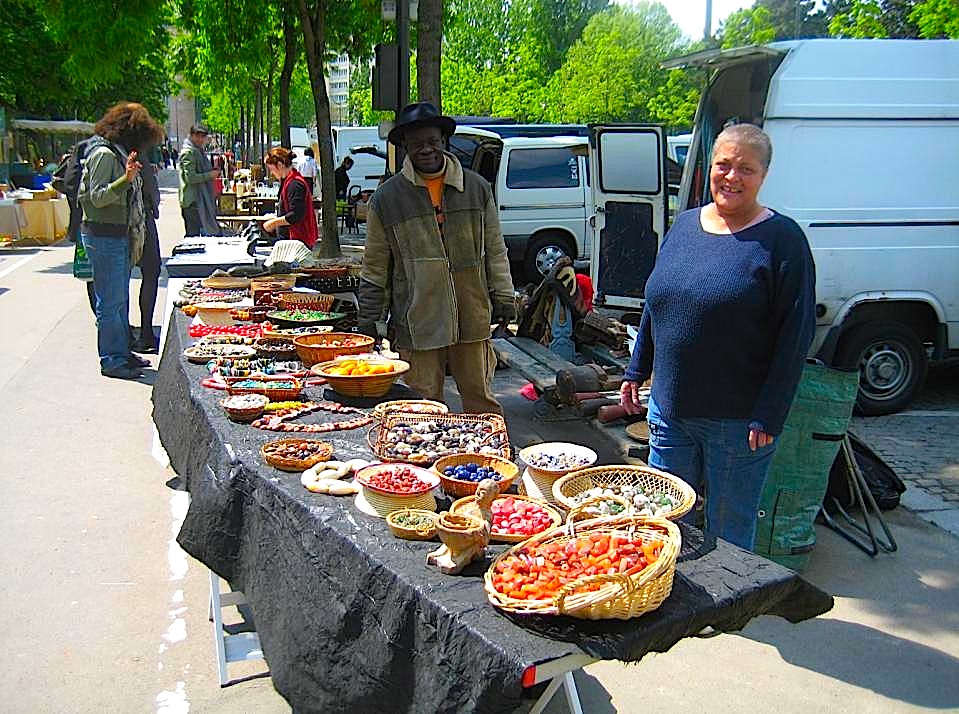
Cinda brought me back to the fifteenth the next day, because there was a vast flea market near the Porte de Vanves that stretched out into the fourteenth. For reasons known only to an honorary Dutch person, she bought lots of vintage tea towels (printed with calendars of 1966, for example) to wash, iron, and hand out as presents, while I trawled for beads, netting some "lost wax technique" bronze beads from Ethiopia, one bronze earring from Togo, and three large, blue sea-glass beads from Mali. (I like to know where my beads come from.) The African lady who sold them was sixty-something, like us, and like the flower-seller who sold us the lobelia for my window pots at the Marché St. Quentin. I have come to believe that sixty is an especially green peak in the cordillera of a human century. Once I installed those feathery sky-blue flowers, the herbs, and some lilies-of-the-valley Cinda bought from a gypsy, my apartment took on a decidedly more cheerful aspect. We welcomed Rémi and Françoise Brague there a day later for champagne and hazelnuts, before taking them around the corner to the Bistrot des Faubourgs on the rue des Vinaigriers, where the cuisine impressed them so much they asked for the card. Since they are veteran Parisian diners, I also asked for a card, went back three times, and was never disappointed. I don't usually think of rice pudding or sardines or the house red as sublime, but there they were.
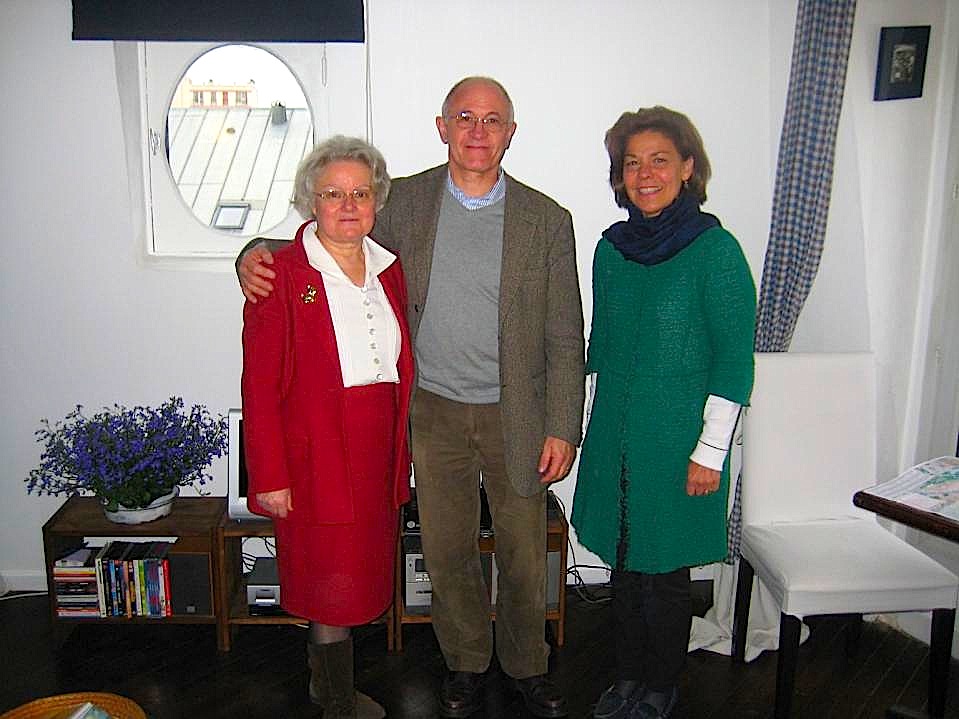
We talked about the differences between Christianity and Islam (if only my husband the medievalist had been there!) and the "secondness" of Roman and consequently European and so too American culture, following themes in some of Rémi's books and then themes in the lives of Bragues and Musters. We discussed the joy and confusion of grandparents. Rémi and I had tried to talk about Rilke that afternoon at Nanterre, but apparently most of the people who read Rilke and Baudelaire were out of town that day, as were five days later most of the people who read Yves Bonnefoy. He and I showed up in the most beautiful lecture hall at the university, and he read the poems I discussed, at intervals, in his sonorous and rather gravelly voice with its lingering trace of La Tourraine. We had an interesting dispute afterwards about the formation and destiny of poems. He thinks that the poet's task is to abstract from and transmute the details of everyday life, attachments to specific people and places that ought to be left behind as inessential, the way a composer turns the succession of events into melody. I think of the poem by contrast as the expression of specific attachments, often flagged by dedications; my own poems are typically addressed to people I love (or, sometimes, hate), and readers are then free to share and generalize them for their own purposes. There never was an almond tree in the courtyard of the house at Valsaintes, he protested, though in one of the poems I analyzed the poet steps outside the house to watch its aetherial bloom in early spring. But when I write about the flux of maples and black walnuts in the forest behind my house, I mean (among other things) to record their real presence and their taxonomic names that I've learned from studying my field guides. I often wonder if the penchant of anglophone poets for the concrete, the specific, the empirical, stems from the metamorphosis of Anglo-Saxon with Norman French (and church Latin and scientific Greek). We know we can achieve a certain intensity and clang whenever we revert to Anglo-Saxon vocabulary, all the more so when the surrounding language engages in romance and metaphysics.
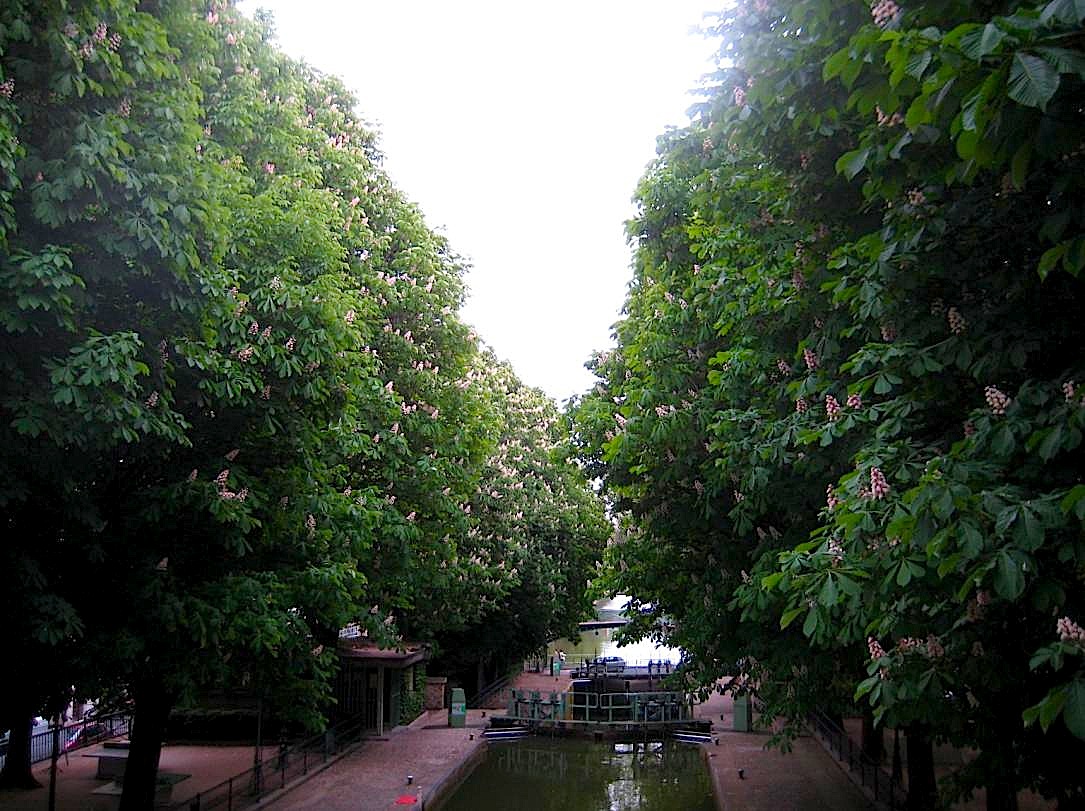
My corner of the Canal St. Martin, since it is unsuppressed, even exuberant, often gives rise to buskers where the rue des Récollets and the rue Lucien Sampaix (a communist journalist shot by the Nazis in 1943) meet on a tiny square, which is actually a triangle. They entertain groups of children with puppets and balloons on days when they are liberated from school, which occur with surprising frequency during the month of May, but only on sunny days, which occur with surprising infrequency. I reserved rooms for Anne Stevenson (the subject of my last lecture) and her husband Peter Lucas at the Hotel Belta half a block from the buskers and Antoine & Lili and a graceful pedestrian bridge that arches like Monet's at Giverny. They arrived on the Eurostar at the Gard du Nord direct from Newcastle and London, amazed that one can settle down with a newspaper at St. Pancras station and three hours later walk out into the bustle of north Paris. I share their amazement, because it took me all day to make my maiden voyage from London to Paris in 1970: a slow train to the coast, waiting in line for the ferry at Calais, the Crossing, another line for customs and immigration, and the Flèche d'Or tracing its strikingly un-arrowlike trajectory to Paris.
I immediately spirited Anne and Peter away to a dinner party at Karine Chemla and Bruno Belhoste's apartment, filled with artifacts from China, on the Square Bolivar (which is, for once, square, though not a park), between the heights of the Parc de Belleville and the Buttes Chaumont. Last year Karine turned the directship of REHSEIS over to David Rabouin (who writes about mathesis universalis and is like me partial to Leibniz), when it merged with CHSPAM (dedicated to medieval Arabic mathematics) to become SPHERE. Karine invited three friends (two denizens of the tenth and one historian of mathematics), and Bruno invited Jean-Paul Avice, whom he met decades ago when they were both posted to Libya, because he and his wife Katrine are old friends of Lucie and Yves Bonnefoy. Jean-Paul recently published a book on Baudelaire with wonderful nineteenth century photographs of Paris before and after the depradations and glories of Napolean III's Baron Haussmann. Karine is friends with Anne's second husband (a specialist in Chinese science at Oxford), and I am friends with Karine because thirty years ago Rémi Brague suggested that I attend François De Gandt's study group on Newton's Principia, where I learned how the proof of the inverse square law really works, and François introduced me to Karine. So everybody was connected to everybody.
After a number of bottles of champagne and excellent Bordeaux, which accompanied Karine's admirable evocation of her mother's Jewish Tunisian cuisine, some of the usual conventions that constrain academic dinner parties loosened, and we plunged into an orgy of... poetry recitation. Epater les bourgeois! Throwing all caution to the wind, Jean-Paul, Anne and I began spouting various poems in French, English, Latin, Greek and modern Greek, portable treasures that ended up on the dinner table like an invisible dragon hoard. Jean-Paul recited all of "Le Cygne," which is very long, and includes Baudelaire's reproach to Haussmann: "La forme d'une ville change plus vite, hélas, que le coeur d'un mortel." Anne, Peter and I managed collectively to remember all the lines of Frost's "The Road Not Taken," and I added some short lyrics by Housman, Keats, Seferis, Millay, and Yeats. I would have sung them if I had been sufficiently tipsy, which fortunately I was not; anyway, my guitar has been out of tune for a quarter century, so I hadn't thought to bring it with me.
Jean-Paul and Katrine and I met again two days later at the Vernissage for Farhad Ostovani's show "Aux jardins d'Alioff" at the Galérie Thessa Hérold, that lies in back of the Musée Picasso (now closed for repairs since it lies in the Marais, which means "swamp" as well as naming the old Jewish Quarter, so the basement keeps flooding). Yves Bonnefoy has worked with a series of artists for the last half-century, and for the past decade, Farhad Ostovani is the artist with whom he has collaborated most frequently, on catalogues and art books. Anne and Peter had shown up on time for the Vernissage in true Anglo-Saxon fashion, like me, looked carefully at the paintings, and then continued on their way to the Place des Vosges. I stood around and chatted with Mme Hérold and read the catalogue, which includes an essay by Bonnefoy, notes by Jean Starobinski and Bernard Blatter, former director of the Musée des Beaux-Arts de Vevey in Switzerland who sadly died last year, and touching photographs. When Farhad was a child, though both of his parents worked in Tehran, he usually spent the summer in his aunt's house in northern Iran, in the town of Lahijan on the tea-covered slopes of the Al'borz mountains. ("Lah" is the Persian word for silk.) Down the street from his aunt's place was a house with a beautiful garden built by a Russian immigré named Alioff. After the fall of the Shah, Farhad's rather liberal parents decided to leave Iran and moved to southern California, an exile to which his father was never reconciled. When his father was dying, a photo of Alioff's garden resurfaced (it is reproduced in the catalogue), and Farhad began a series of studies of that garden, always viewed from outside and transformed by memory. In one or two of the paintings, the house is depicted in precise detail, but in others it is reduced to a geometric figure, a square or cube, that sinks into or floats above a dream landscape that bears the evident traces of the artist's hand, incising, erasing, supervenient.
Finally, when my feet were beginning to hurt, Farhad and his friend Robert Bemis arrived. Robert had just retired from the diplomatic service; if you mention almost any city in the world to him, he has been there and has a charming story to tell. Jean-Paul and Katrine followed, and Franklin Chow, the Chinese painter and calligrapher whose show preceded Farhad's at the gallery, and Farhad's elegant sister wrapped in a burnt-umber shawl. Also students and imposing business people and dapper young men in long pointy leather shoes who gave the impression of walking on baby crocodiles. The only people who didn't show up, alas, were Yves and Lucie Bonnefoy, since a household accident put Lucie in the hospital overnight (but she was soon on the mend and back home). I sat next to Jean-Paul at dinner afterwards in an elegant restaurant with a domed ceiling, but neither of us recited poems due to the gravity of the occasion.
In between dinner at Karine's and the Vernissage, I lectured on Anne Stevenson's poetry, the way she represents time, and the uses she makes of memory and epistemology. (Her father was the philosopher Charles Stevenson.) A longer, more detailed version of my lecture will be included in a collection of essays on Anne's poetry, soon to appear from Liverpool University Press. Claude Imbert attended, bless her, as well as the poet and translator Robert Wells, who took the train up from Blois where he lives with his French wife Marie-Christine, and who brought copies of his recent Collected Poems and Translations from Carcanet. It was a happy reunion, because Anne Stevenson was one of the first people to review and appreciate Robert's poetry thirty years ago, and he has been an admirer of her poetry for even longer.
After the lecture, I staged my sole dinner party in the apartment on boulevard Magenta, which was like pulling a fan of peacock feathers (or perhaps a live peacock) out of a top hat, since I only had a hot plate, a microwave, and a pint-size refrigerator. However, I made salad from a gorgeous oakleaf lettuce purchased at the Marché St. Quentin and served omelettes one by one from my small frying pan. There were baguettes "tradition" and tartes aux framboises from the bakery on Rue du 8 mai 1945, and we polished off a few bottles of Bordeaux "grand cru," which helped. Anne and Robert reminisced variously about writing for Michael Schmidt at P/N Review, Jon Silkin at Stand, and editors at the London Times, and told stories about the London poets, the Oxbridge poets, and the Northern poets, the poets and bookstores at Hay on Wye, the poets who loved Latin and the poets who despised it, the Movement, my friends Donald and Doreen Davie, Robert's beloved mentor Thom Gunn, Plath and Hughes, Bishop and Lowell, expeditions through Persia and India, our friend Dick Davis, and the distant green expanses of Michigan.
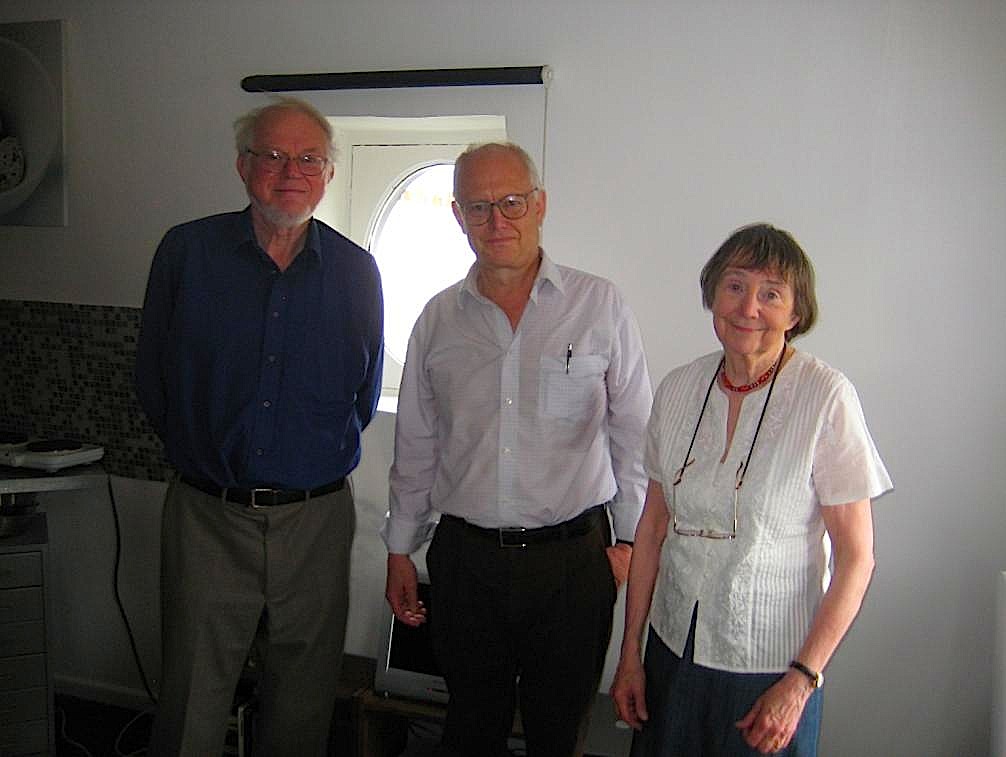
Of course, it was the taste of friendship that enlivened that meal. When Anne and Peter left for Switzerland, the horse chestnuts had finally lost their bloom and the paths along the canal were adrift in a snow of flowers. I took the train out to Evreux in Normandy to visit my friend Patience Tuhwe, a political exile from Zimbabwe and mother of a school friend of my two youngest children, William and Mary-Frances. Patience was an accountant and legal secretary in Harare; after taking many computer courses in Paris, she was hired by a primary school near Evreux to teach the children computer skills and eventually also English. When I arrived in Evreux, we walked down to the Centre-Ville to inspect the cathedral.
Evreux has been a bishop's seat for sixteen hundred years, and during the Middle Ages was also a center of Jewish learning. The grisaille stained glass windows threw flocks of dull gold, gray and crimson across the clearstory at midday. We talked about the flowering trees of April and early May, the cherries, the horse chestnuts, the paulownias; Patience remarked that when they were all in full bloom, against the background of purple, red, and acid-green foliage of early spring, she briefly felt at home, but then was disappointed when they vanished so quickly. She thought they might stay that way for months, like the jacaranda trees along the avenues of Harare.
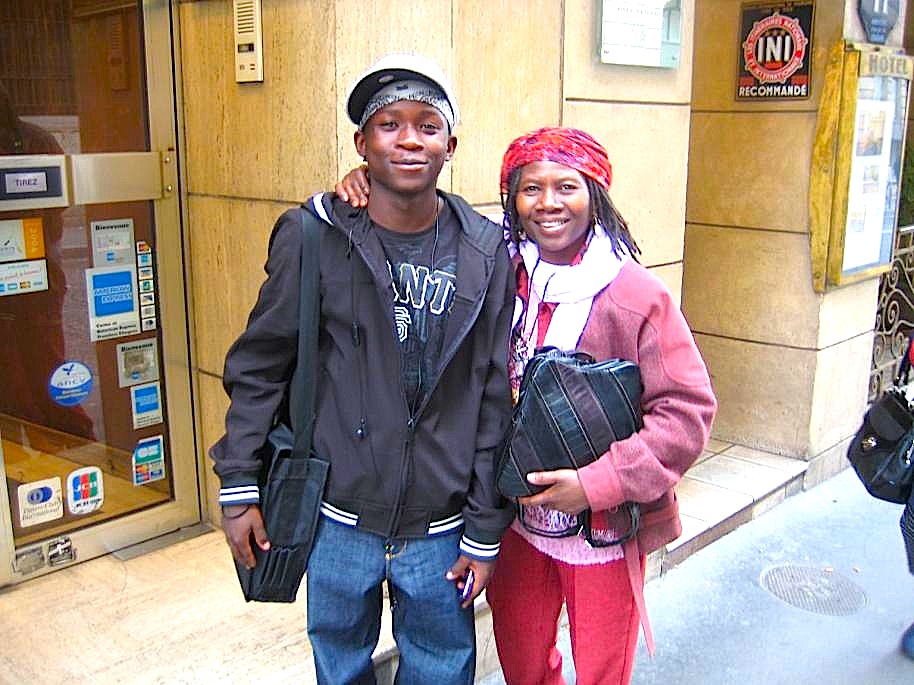
Because she lived in subsidized housing, Patience's apartment was not in the town center but about five miles outside, in a vast collection of highrises and stores populated mostly by immigrants. She was worried by the clusters of older and quieter or younger and noisier men who sat around on the threadbare lawns as she walked to her building; they didn't look threatening to me since they seemed to be attached to groups of cheerful, clear-eyed small children, though I did wonder why their wives weren't sitting with them. I also wondered why the empty lawns couldn't be converted to vegetable and flower gardens. Patience would have liked a patch of her own. Her apartment was enlivened by houseplants, goldfish, and two talkative parakeets, as well as a montage of photographs of her family and natal village: windows onto a lost world. Her son Tanaka was going to school in Le Havre and visited on weekends; her three other sons were scattered in Paris, London, and Harare. She liked Wangari Maathai's memoir, Unbowed, which I sent her last year when I taught it in a philosophy of biology course. Maathai's Green Belt Movement is responsible for planting 45 million trees in Kenya. In 2004, she won the Nobel Peace Prize.
On my return to Paris, I greeted another University of Chicago friend, Roberta Caplan, whose dorm room was catty-corner from mine during our freshman year; she is now a psychologist at Brandeis University. We bicycled together from Salzburg to Strasburg in 1977 (and then Sarah Glazer and I met up and bicycled along the Dordogne to Cluny, Lyon and Dijon). Our trek ended in Paris: Roberta and I share one vivid memory of looking for a hotel at midnight in the Place de la République, because the cheap hotel room we'd booked and paid for turned out to have battalions of insects roaming its walls. The guy at the front desk came up with some bug spray and filled our room with toxic vapors, but only a few of the bugs actually died, so we left. Since Roberta likes to walk (and run), I took her on one of my favorite walks—not along but across the Canal St. Martin, over towards Karine's apartment in the nineteenth, which means in general going uphill as the rue du Faubourg du Temple becomes the rue de Belleville or the rue des Chaufourniers leads up to the Avenue Simon Bolivar. We crossed the canal on the pedestrian bridge and headed down the rue Bichat, which skirts the great walls of the Hôpital Saint Louis, originally planned by Henri IV to handle the tens of thousands of dead and dying produced by the plague in 1562. I wanted to show her the lively street market along the rue du Chalet and the Impasse Sainte Marthe, but by late afternoon it had all closed down, so instead we made a detour south to look at the Eglise St. Joseph, and then north up the rue de Belleville where we briefly found ourselves in Shanghai (well, everybody spoke Chinese). Halfway up we paused to admire a post-modern installation that occupies the flank of an apartment building: a mannikin on a scaffolding (who at first looks very real) had apparently just painted the words "Il faut se méfier des mots—Be suspicious of words.
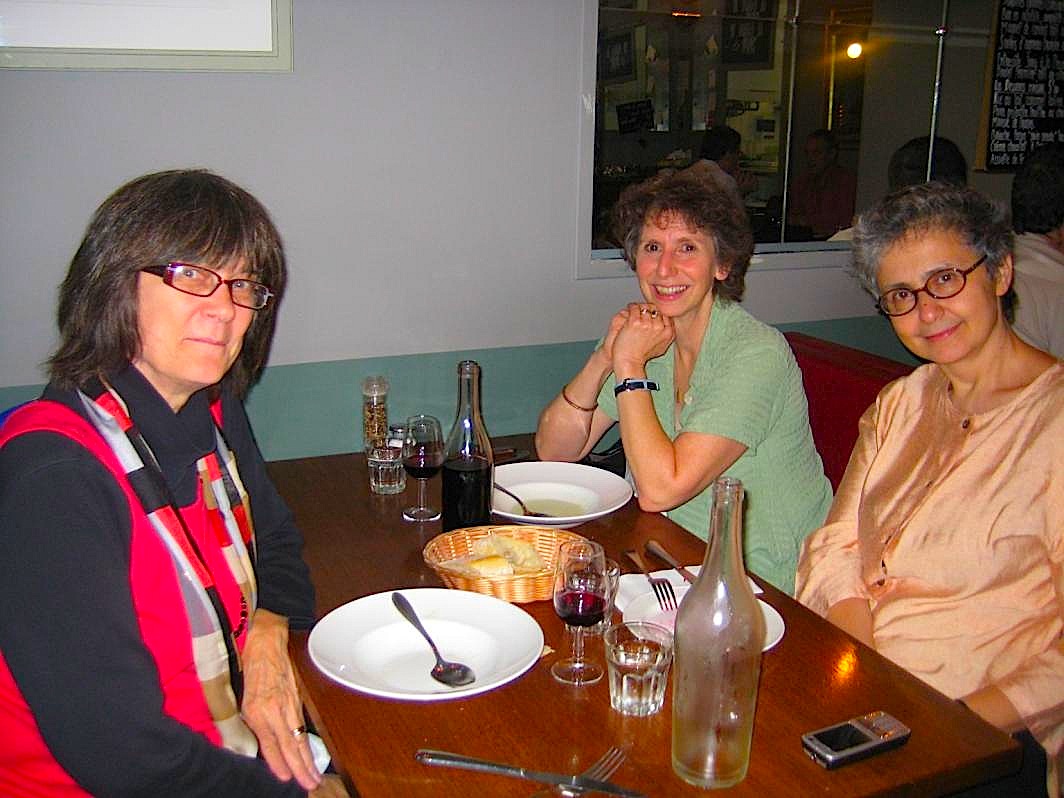
Continuing upwards and turning right on the rue Piat, we arrived at the Parc de Belleville, where gardens and streams cascaded downwards at our feet, the Musée de l'Aire offered its enigmatic rooms devoted to what can only be breathed but not touched or seen, and a panorama of Paris—rival to the more famous view from the steps of Sacré Coeur—extended from northwest to southeast. We walked roundabout the rue de la Mare and the rue des Cascades, where Belleville's artists were offering their semi-annual "Journées Portes-Ouvertes," so that anyone with the appropriate, starred map can visit the designated ateliers, meet the artist and see the work in situ. Where those hillside streets curved around, a café and art center were tucked into the bend next to an eighteenth century covered fountain, fed by a source active since Roman times and graced by traces of ancient vineyards.
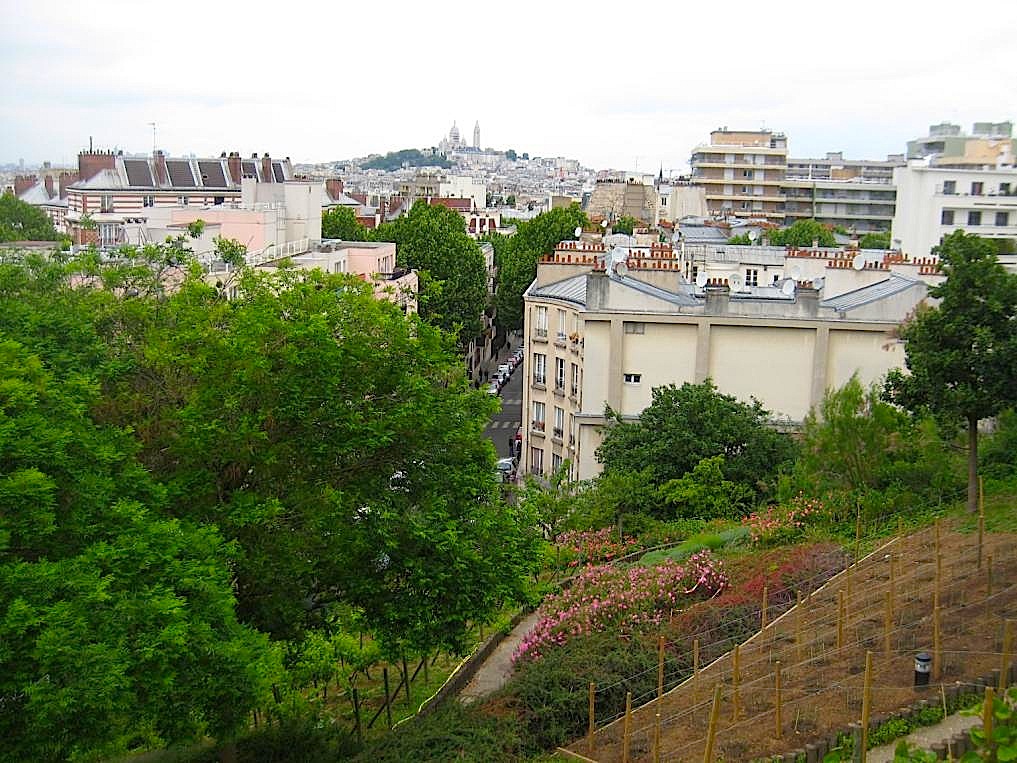
We then fell upon the Avenue Simon Bolivar (as the French say) and walked around the tip of the Parc des Buttes Chaumont to a very steep flight of stairs that led up to a cluster of aerial houses along the rue E. Poe. (For some reason French people always call him Edgar Poe; perhaps his admirer Baudelaire was the first to drop the Allan.) Up there we came across another unexpected, breath-taking view at the edge of a community garden and sloping vineyards (real, not remembered), across to the hill of Montmartre and Sacré Coeur. After that, we were really tired and went home via the rue Camus and the place Desnos, for a cup of tea and strawberries from the Marché St. Quentin. Since Roberta is a psychologist and wise, we spent a number of hours talking about old age and death, which are now within hailing distance, since they have claimed our parents, lots of aunts and uncles, a few friends and cousins. My hands hurt, and her knees hurt, and we both take calcium pills and vitamin D; we both don't look forward to the empty nest, and neither of us are ready for grandchildren. The immediate question seems to be how to avoid the foolish decisions people make when they think they can run away from mortality, and how to enjoy the day when you are gathering, not rosebuds, but somewhat overblown, somewhat darkened roses in shadowy foliage. But still roses.
Now that I am back home, I think of Housman's admonition that "to look at things in bloom / Fifty springs is little room." By his reckoning, I only have ten more, which is threescore years and ten minus threescore, thought I'd prefer to subtract my threescore from a hundred. Time will tell. He might in fact have gone about the woodlands to see the cherries hung with snow, but he also wrote the poem. By writing this essay I have tried to revive the things in bloom I saw and thought last month in Paris, for myself, for my children and husband, for the friends who accompanied me, and for you, gentle reader. The next time you are in Paris, don't forget to cross the Canal St. Martin where it bends to accommodate the Square Villemin and the Hôpital Saint Louis, and the rue des Vinaigriers turns away from its bank in a flight of stairs, and the lock empties whenever a barge, however unlikely, needs to change levels as it seeks the consolation of the river Seine or farther beyond, where the river folds itself into the ocean, Finisterre.
